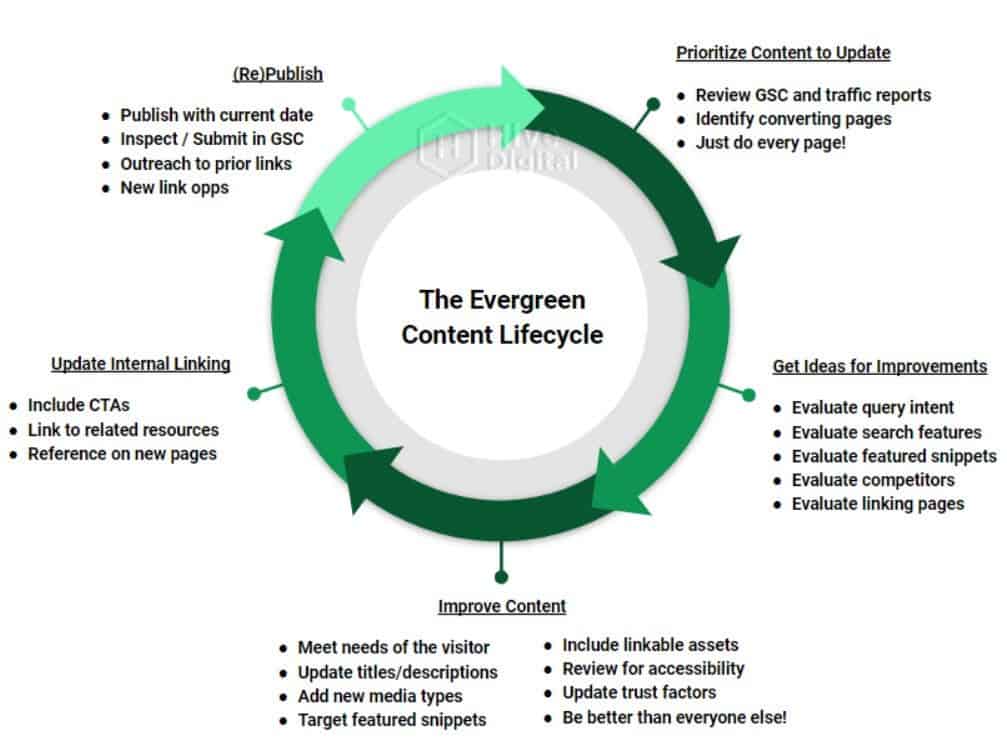Blog articles are often a place where relevant content goes to die. Meaning, that a good idea, which expands a site’s relevance for topic groupings or a subject matter is curated and forgotten after being pushed live to the site. Most often, blog content skirts the edge of your main category pages and acts as supplemental information for your readers in what should be a valuable medium. Then again, most of the written content out there should quietly fall away without gaining the attention of an additional set of eyes. But that doesn’t have to be the case for your site!

Most websites have a content production calendar, and as a best practice, have a goal set for regularly publishing new content. Well, the same sort of cadence should be employed for refreshing existing subject matter and blog articles on your website. Generally, at least once a year, you should refresh a landing page as a part of the blog’s life cycle. Looking at the topic’s importance, the intent of the content, and the SERP Landscape for ideas on how to improve and expand the landing page.
Which Articles Should I Revisit?
Good question!
Content should not be written, just for the sake of writing content. The underlying intent of a landing page should be to supplement the purpose of your website. Website assets should be able to enrich a user’s experience on your website, and if they do not, then they are not worth your time. It is just as important to identify relevant landing pages to revisit as it is to recognize a lost cause.
Article importance depends on a number of factors, but most importantly, you should be aligning the intent of your business or website with the topical relevancy of your blog content. Most often, when we revisit blog articles, we like to prioritize by overall Organic impression share. Generally, we look at the last 12-16 months worth of Organic data in Google Search Console filtered on the blog folder and sort the existing content by Total Impressions.
Viewing content by Total Impressions provides an additional layer of inspection, that can speak volumes to the health of a piece of content, and its ability to convert. Most directly, from this view, we can use Click Through Rate (CTR) by extension to look at how well a landing page is performing. From a top-down perspective, we like to look for High Impression, Low Click pages when prioritizing a Blog revitalization strategy.
Looking at High Impressions, Low Clicks is indicative of fairly decent content, with a poor Call to Action (CTA) or page Title and Description. This is food left on the table, as Google is choosing to give your content exposure, but you are unable to close the deal and convince potential visitors to click through the SERP and land on your site. Our opinion is that we start easy, and work our way up!
If you don’t have 1,000’s of old blog posts to review/prioritize, then we typically recommend you start at your oldest post and work your way forward. The overarching goal is to take any piece of content that could be dated, and improve upon it… or if the content is worthless, go ahead and redirect it to a more relevant/appropriate page (e.g. taking a page that talks about an event in 1999 and redirect to a category page highlighting upcoming/recent events). Honestly, you should establish this as an ongoing process for pruning/managing content.
Use the SERPs to Develop Ideas for Improving your Content
Google’s Search Results provide a plethora of information that you should use to help drive content creation. In effect, Google has chosen what it sees as the most relevant information and page type when serving content to its users. As a writer, use this information to your advantage!
The first step to using Google’s own landscape to your advantage is to identify the main key phrase or topic for your content piece. Go to an incognito window and type that phrase into the search engine. Take note of what Google returns. Are there featured snippets, quick answer boxes, or other forms of media? What types of titles/descriptions appear in the top results? What types of sites are appearing (informational, transactional, comparison results, etc.)?
Draw upon Google prioritizing forms of content, and using this outline as a guide for examining your own landing pages. Ask yourself whether your own landing page answers whatever it is that the user searched for better than the site ranking #1.
If the answer is no, then keep reading and put these next steps to optimize your content into everyday practice:
General Content Improvements
Most articles contain references to outdated resources, mention products that may no longer be offered, include product images that are dated, etc. Make sure to conduct a general review of the content and ensure that it continues to be a good representation of your brand and that it can still be a great resource for your visitors.
This is also a great time to introduce / update the media presented in the page. Can we provide a better image? Can we embed video? Can we include charts, CTAs, a highlight of the author’s bio, etc.?
Another handy tip is to review the source content on inbound links. Often times you’ll find yourself mentioned on other websites as part of a list of other resources with information you should consider, or you’ll find commentary from the author of an inbound link that could be helpful as you work to improve your content. Sometimes, it may even be helpful at this point to reach out to them and see if they want to contribute to the improvements you are making. This can be great ego-bait to get them to re-share your content once it is republished, or take a similar approach with their content.
Update Media & Time Sensitive Resources
Google’s web crawlers have been known to increase crawl budget and frequency as they recognize revitalized content and new data that could be useful to readers. This often works to reinforce the strategy of providing a better content breadth, and topical relevance as it relates to time-sensitive information.
In most cases, your blog posts likely contain an outdated reference to data, studies, or media from the given year. In fact, we typically recommend clients include time sensitive resources in their content such as statistics, graphs, charts, pop-culture references, and similar within a content piece to better leverage the content as a linkable asset, as well as to better engage with the audience… it also forces the client to revisit/update the page more regularly 🙂
These elements should be updated and maintained, so over time the content can be updated with the latest statistics, and ideally, you can update the article to highlight the differences in the data over time and build a more robust resource
Depending upon your CMS, as you update this content, it may also be helpful to re-publish with the current date in order to move the post to the front page of the blog or category archive and indicate this is now a fresh piece of content. This will also update the date displayed in the SERP for the content piece, as an article may often rank well, but lose on the CTR due to the date displayed in the SERPs.
Note, we do not recommend changing the dates on articles if you have date based URL structures, as this can create other types of issues with redirects, etc.
Attack the Featured Snippet
You can use aHrefs and similar tools to identify the keywords generating featured snippets for which your site is ranking. Obviously, for a given topic, phrase, product, or subject it is important to determine whether it is within reach. Most often, sites that are included within a featured snippet are already ranking on the first page, and are in direct competition for the most relevant content.
Often, there are small tweaks and topical inclusions that can be developed to target these opportunities. Typically these changes involve one of the following:
- Clearly defining an answer within your content – Do you clearly answer the related questions within your content? Oftentimes, the answer can be found within your page, but it can be helpful to clearly state the answer. E.g. “A rhinoceros will typically live 35 years in captivity.” Clearly answers the question “How long do rhinos live in captivity?” vs. an article that says “Rhinos can live anywhere from 30 – 60 years depending upon where they live. Rhinos in captivity tend to live shorter lives than those in the wild”.
- Using appropriate markup within your content – Does the featured snippet appear as an ordered list? If the current feature is instructional or a ranking of items, make sure you are using the <ol> html elements vs. listing them in a paragraph or manually numbering them in the content and placing on the page. This makes it more clear to the search engine that this is a list item, and increases your chances of being included in a featured snippet.
By making these often subtle changes, you can often grab the featured snippet… worst case scenario, your content is better for your visitors and you increase your long-tail traffic.
Update Your Internal Linking
While you are spending time improving the content on a given landing page, take the effort to update the internal linking across the site. You have likely created new related content on your site since the article was originally written, and now have additional information you can cross-link. Additionally, make sure that you introduce calls to action where appropriate.
Give Thanks, Get Links
When you update a content piece, this is often a great time to reach out to the sites that are linking to this page and foster the relationship. You can thank them for taking the time to link to your website, and let them know that you’ve made some updates to make it a better resource for their visitors. You can reshare it with them on social media, while linking/referencing their linking content piece.
It’s also worth looking at the backlinks of competing pages to see if you can poach off from your SERP competitor’s link profile… after all, your content should be better than theirs now!
Frequency of Content Revitalization
The pace at which you revisit content really depends on your own resources and ability to provide additional value to your users. Blog pages should be revisited at least once or twice a year to confirm the article’s intent matches the queries for which it ranks, and ensure it is the best resource for the space. This is often far more advantageous than constantly working to create new content that all too often simply competes with your outdated version of the same content.
For a more in-depth review or request for our team to look at your site’s content, please feel free to contact our team at [email protected] or find me on Twitter at @JohnGibbings!JUMP TO A CATEGORY
WEB ANALYTICS | SEARCH OPTIMIZATION | PAID ADVERTISING | COMPANY NEWS










